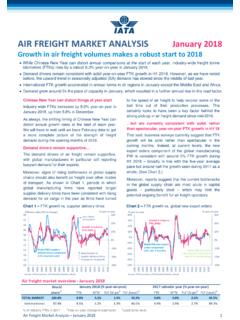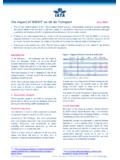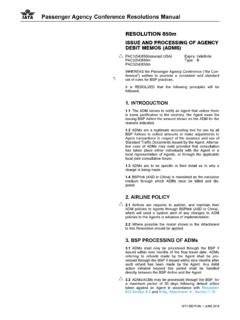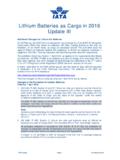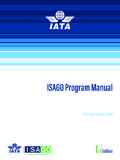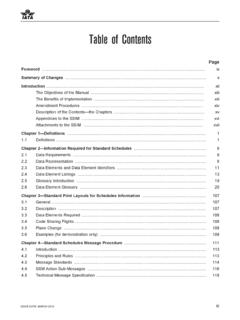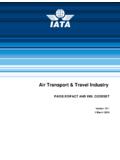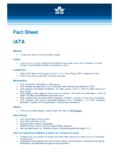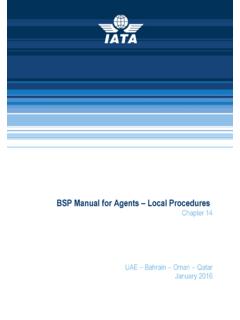Transcription of The Future of Airline Distribution, 2016 - 2021
1 The Future of Airline distribution , 2016 - 2021By Henry H. Harteveldt,Atmosphere Research Group2 2016 International Air Transport Association. All rights INTRODUCTION5 RESEARCH METHODOLOGY7 EXECUTIVE SUMMARY9 HOW SHOULD airlines PREPARE TO SERVE THE Airline TRAVELER OF 2021? 26 TECHNOLOGY INNOVATION AND THE EVOLVING TECHNOLOGY LANDSCAPE29 Airline distribution IN 202170 CONCLUSION72 ENDNOTES3 2016 International Air Transport Association. All rights from Atmosphere ResearchAtmosphere Research Group is honored to have once again been selected by IATA to prepare this report on the Future of Airline distribution . We believe that the five-year timeframe this report covers 2016 to 2021 will see the successful introduction of true retailing among the world s airlines and their distribution report reflects Atmosphere Research s in-dependent and objective analysis based on our extensive industry and consumer research (for more information about how the research was conducted, please refer to the Research Method-ology section).
2 airlines that want to become true retailers are well-positioned to do so. Carriers have an abun-dance of technologies, including cloud comput-ing, artificial intelligence, and mobility, that they can use to help them bring their products to mar-ket in more meaningful ways. IATA s NDC, One Order, and NGISS initiatives are being brought to market to help airlines be more successful busi-nesses. As each Airline independently contem-plates its distribution strategies and tactics, we hope this report will serve as a helpful 2016 International Air Transport Association. All rights from IATA In 2012 IATA commissioned Atmosphere Research to conduct a survey on the Future of Airline Dis-tribution. The report was widely distributed and commented on across the industry. Four years on, IATA thought it was time to publish a new report, which takes another look at the near Future . IATA is keen to understand what could shape or influence Airline distribution , and to share those findings with the industry.
3 Although the Future has become less and less predictable, some key trends can certainly be identified. The pace of innovation and change is accelerating, prompted by worldwide access to Internet and the rapid development of mobile, amongst many others factors. And all this is strongly impacting Airline distribution , opening opportunities for new models, new players etc. Concepts or wordings such as open API, XML, big data, json are now widely used well beyond the developer s sphere; and Hackathons are proving that agile solutions can be built in a period of 40 hours, competing with a 40-year old technology. Game changes are prompted by consumer needs, or by the ability to offer new solutions. Also, the payment landscape will evolve very significantly with the rise of new payment instruments provided by new players as well as the changes in payment architecture. This report aims to play back industry views on distribution trends based on interviews with many players across the value chain.
4 It also entails two IATA initiatives (NDC and One Order) as they are mentioned by interviewees as structural game changers. The views gathered in this report are not IATA s views but those expressed by industry experts and we welcome any feedback or comments that will help us better anticipate Future needs of the industry and its Airline members. Whether you work for an Airline , a distributor or an IT provider, we hope you will enjoy the reading! Yanik Hoyles, Director NDC ProgramFuture of distribution Report 2016 -2021 5 2016 International Air Transport Association. All rights analysis in this report is based on extensive independent research conducted by Atmosphere Research. We: Fielded on online study with 49 Airline participants. In collaboration with IATA, Atmosphere Research developed a 24-question, English-language online study. The study was fielded in March and April 2016 , and targeted Airline distribution professionals at both network airlines and LCCs worldwide.
5 Participants who took the study were promised complete anonymity; no personally identifiable information was collected or majority of participants (42%) hold Director/Managing Director roles, 34% are Vice Presidents or SVPs, 22% Supervisors or Managers, and 2% C-level roles. Sixty-three percent work in distribution , 17% in Digital Commerce, 10% in Marketing, and 10% in Executive roles. Ninety-one percent work at carriers whose 2015 gross passenger revenues were US$1 billion or more. Seventy-one percent work for network carriers, 27% work for LCCs/ULCCs, and two percent at regional airlines . The audience was geographically diverse: 34% work for European-based airlines , 22% for Asia-Pacific airlines , 20% for airlines in North America, and 12% each at airlines based in Latin America and in India/Middle majority, 63%, of participants work for carriers that belong to one of the three major Airline alliances (Oneworld, SkyTeam, Star Alliance).
6 A substantial number, 44%, work for airlines that have a joint venture with at least one other carrier. Conducted 21 telephone interviews with Airline executives and managers. After the online study was completed, Atmos-phere Research conducted telephone inter-views with Airline managers and executives at 21 network airlines and LCCs around the world. The phone interviews, which were con-ducted in April, May, June, and early Septem-ber 2016 , generally lasted between 40 and 50 minutes. In keeping with research best prac-tices, the Airline participants were promised confidentiality and anonymity. Interviewed 17 technology vendors and in-dustry consultants. Between April and September, 2016 , Atmos-phere Research interviewed or was briefed by 17 technology firms, including both general technology vendors and Airline -focused pro-viders, and consultants to obtain their per-spectives. Two of the 17 firms required their interviews be considered anonymous and off the record, not for attribution.
7 The compa-nies that we interviewed or were briefed by for this report, and are allowed to name, are:o Air Black Boxo Amadeuso Concuro Datalexo Edgar Dunno Farelogixo IBS Softwareo Infosyso Lufthansa Systemso OpenJawo Sabreo SAP Hybriso Tr avel p or to Triporatio Wayblazer RESEARCH METHODOLOGY6 2016 International Air Transport Association. All rights reserved. Leveraged Atmosphere Research s global traveler research. Throughout this report you will see data from Atmosphere Research extensive research studies of Airline travelers. Research sources include both the seven-country Q3 2015 study of Airline passengers that Atmosphere Re-search conducted on behalf of IATA as well as data from Atmosphere Research s proprietary traveler research. Data sources are cited in the Endnotes section of this report. As is typical of a report like this, extensive desk research was also conducted. Citations for all third-party data and information can be found in the Endnotes section.
8 Disclaimer IATA funded this report and provided administra-tive and editorial feedback and support during its development. The views and opinions expressed in this document are those of Atmosphere Re-search based on its research and analysis, and do not necessarily reflect the views of IATA or its member of distribution Report 2016 -2021 7 2016 International Air Transport Association. All rights SUMMARYThe Future of Airline distribution is, to a great de-gree, the commercial Future of the Airline industry itself. airlines want to be dramatically more ef-fective in how they sell, so that travelers find the value they seek and airlines can be more success-ful businesses. We believe that, by 2021, Airline distribution will evolve from its current passive, rigid, and technology-centric state to a more flex-ible, dynamic, and passenger-centric environment which we call Active distribution . Between 2016 and 2021, the Airline distribution community and their colleagues in closely-related roles such as Marketing, Sales, Product, Pricing/Revenue Management, and IT should anticipate a multitude of changes among their passengers, the technology landscape, and within the Airline commercial environment.
9 These include: Serving a dramatically different base of passengers. By 2021, airlines will serve a more geographically diverse base of passengers. This includes so-called Emerging Markets and Developing Economies (EMDE), such as Indonesia, Iran, Mexico, and Turkey. A growing number of consumers age 65 and older in several dozen countries means that Airline distribution systems and the channels they power must be designed to accommodate a divergent nature of users. Both Airline direct and third-party retailer channels must distinguish airlines and their product offerings from one another through engaging, intuitive shopping experiences that tap into traveler s second wallet , the wallet that controls discretionary purchases. Passengers will also be entering a post-mobile world, a world in which mobile is not viewed as a channel but the channel. The need to incorporate and interact with scores of new technologies.
10 By 2021, Active distribution will require sys-tems that are either based on, or compliant with, numerous new technologies. Mobile alone will introduce the need for distribution systems to interact with speech and voice recognition software both of which contrib-ute to the emerging conversational commerce trend haptics, and more. Artificial intelli-gence, which also encompasses numerous technologies and processes, will play a central role in enabling the dynamic pricing and per-sonalization that airlines will need to become authentic and effective retailers. distribution systems will need to interface with virtual reality software to help airlines effectively merchandise their products in a compelling, captivating 2016 International Air Transport Association. All rights reserved. Accepting that Active distribution will be both a catalyst of and reaction to change. Active distribution will itself both cause and result in an extensive mix of actions and reac-tions across the Airline distribution community.
